.,

Jazmina, Yoga District Teacher Training Alum
Ever contemplated becoming a yoga teacher?
What happens in yoga teacher training? Will it be 12 hours of non-stop yoga? Is it like taking yoga class after yoga class? Does the training have a sense of community? Is the history of yoga and different yoga practices taught? Does the training include teaching yoga in a greater context? Will the training suitably instruct me to teach others?
Yoga teacher training no longer needs to be a mystery. Jazmina, a graduate from Yoga District’s Teacher Training, shares her experience.
Teacher Training Essentials
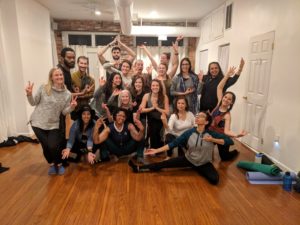
Jazmina’s Teacher Training Group
To begin yoga teacher training can be a difficult decision. There are multiple schools, styles, and teachers that offer trainings around the world. Each training is its own unique experience. It’s a challenge to figure out which option of training is best suited for you.
My decision to begin yoga teacher training stemmed from my experience in the hospital system. I was a practicing physician who eventually burned out and decided to change my career. However, I still felt I wanted to be of service to the medical community. I recalled the positive effects of yoga on my mental health throughout medical school. During my hiatus from being a practicing physician, I could experience multiple fields of mind-body medicine such as yoga. I initially chose Yoga District because they provided the option to complete teacher training as a work-study program.
Knowing a little bit about my participation in Yoga District’s Teacher Training might offer some insight into a yoga teacher training.
Overall Effects of Teacher Training
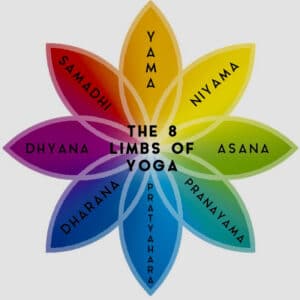 There were 2 common misconceptions about my teacher training. One, that I was tired from doing yoga all day. Two, that my training only consisted of: learn the pose, its name, and create a practice session based on that information.
There were 2 common misconceptions about my teacher training. One, that I was tired from doing yoga all day. Two, that my training only consisted of: learn the pose, its name, and create a practice session based on that information.
In training, as a budding yoga teacher, I came to know a part of myself that goes beyond the practice of asanas. The Heart of Yoga taught me that there is more to yoga than just the asana, which is only one of eight limbs of yoga. I learned the technical aspects of yoga and a more in-depth knowledge of its history. The benefits of yoga, meditation, and the sutras is often the reward of persistent practice.
A prospective student should expect a well-rounded training program. One that includes all eight limbs, in addition to their effects on the mind and body. During teacher training, I learned the asanas were performed as a preparation for the meditative aspect of the practice. Once I realized this information, the asana practice was more meaningful and filled with purpose.
Some students may underestimate the value of savasana as part of the meditative process of yoga. Yet it is essential for a student to integrate the mind, body, and spirit into the present moment.
Contemplative Nature of Yoga
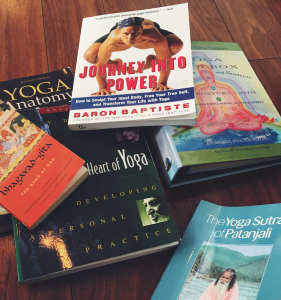
Teacher Training Books
It is in the silence of savasana, that I began to recognize the journey of my ego and its effect on my daily life. I am defining the ego as a term used by Buddhists and in the yoga sutras. The ego being a form of personality or identity in the human mind. Buddhist and yoga sutra teachings remind us that this “ego” is not our true self but a temporary construct.
According to Marshall Stern’s book Meet the Buddha, Kill the Buddha (2016), the human ego is generated out of self-protection in the early developmental years of a person. I had questioned my sense of belonging, value to the community, and how people defined my personality.
My “aha” moment during Teacher Training occured when as a group we read Yoga Sutras of Patanjali and The Heart of Yoga. I learned that in theory the practice of yoga is aimed at dissolving the ego and silencing the mind. This is a way to reach our true self. During training other students’ perspectives made the content from those books clearer at times and deepen my understanding.
Yoga Teacher Training vs. Social Media Yoga
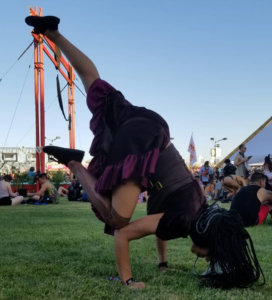
Jazmina’s One Legged Crow, Yoga Pose
Yoga teacher training challenged the social media version of yoga that I found pervasive in our modern world. I was inundated with images of Instagram gurus wearing expensive yoga clothes and performing difficult poses. The real practice of yoga can be blurred by its social media portrayal.
In the beginning of yoga teacher training, I struggled to concentrate on my own practice. It was hard not compare myself to others in the studio and on social media. Until teacher training, I only practiced yoga at home through online courses and apps. I would also compare myself to my past abilities to get into a certain pose, further deepening my frustration. I finally through introspection, figured out why I needed to be competitive and whom I was trying to impress. The stress-filled competitive mentality I lived with my entire life did not fit into the future I wanted. Nor was it suitable for my yoga practice. I began to take child’s pose more often and reminded myself to laugh. I focused on the effects each asana had on my mind and body.
Benefits of Teacher Training
Through the practice of yoga and teacher training, I regained what I view as yoga’s “true value.”

Child Pose
As an athletic active individual yoga was the physical release of stress for me. Its true value is in its ability to prompt me to ask, “Who am I today?” Yoga may start as a physical change in lifestyle for you. Then it might blossom into a wonderful journey of self-discovery and playfulness. Its effects on the mind tend to sneak up on the unsuspecting practitioner in a good way. A yoga enthusiast can have 6 months or 60 years of experience. Both will be able to learn something new each time they hit the mat–if they are willing.
Teacher training was an antidote for me to the Western culture social media and promotional image of “real yogis”. If you type the word “yoga” into a online search bar then the results may be intimidating to beginner students.
In yoga, every pose teaches humility through surrender and staying present. Teacher training taught me about the act of nonviolence (ahimsa). Prayer pose is intended to show respect and humility towards our teachers (on and off the mat). Child’s pose is an asana that can demonstrate humility during practice by acknowledging one’s constitutional limits and bowing to the body’s need to rest at that moment.
Checking in with Body & Mind
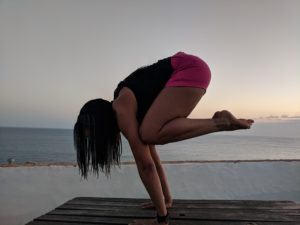
Jazmina’s Crane, Yoga Pose
Yoga teacher training helped me recognize that the body and mind are always changing and thus impermanent. An asana that was easy one day may feel impossible to get into another day. A person’s insight and awareness will steadily improve throughout the training. I recognized that there is and always will be a flow to every action and every thought. During challenging poses, the teachings of yoga guide me in how to collaborate with the ego instead of fight it. Questions such as:
- Why do I feel the need to push myself today?
- What will it teach me?
- Who am I trying to be at this moment?
- Am I truly being authentic?”
The answers to all of those questions helped my personal evolution.
A Sense of Community in a Yoga Class
As a novice yoga teacher, I learned that yoga can be an entirely personal and independent practice. Every expert was once a beginner. This is something that I had difficulty in remembering as a young yoga student. A yoga teacher should remember that a student on the mat, might be struggling with a challenge. In creating a supportive community, a teacher can help students achieve great growth both physically and mentally.
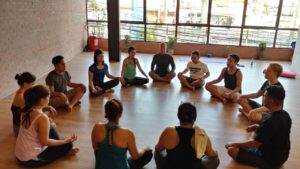
Sense of Community
Yoga teachers must become guides for students both new and advanced. I love to connect with students at the start of class during the introduction. I learned this from one of the first classes I attended at Yoga District. That teacher would share a small personal experience of the day during his class introduction. It was personal, welcoming, and gave an opportunity for other students to find similarities through interacting with one another. It took away the slight awkwardness of stepping into an unfamiliar environment.
As a yoga teacher I hope to embody a similar sense of community in my classes. I realized one day that I will never be perfect. So why should my practice be something that I will not become? By embracing imperfection, I might find happiness. I was then able to move forward and enjoy each practice with a fresh perspective. I knew that even if I repeated the same flow every day, each experience would be different. As a newly certified yoga teacher, I hope to show students that sometimes a little bit of imperfection is necessary. It is how to become the most authentic versions of ourselves.

